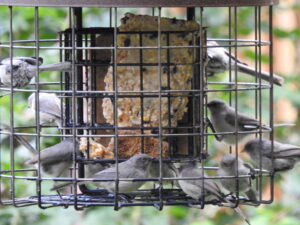Backyard Birds - Late Summer Hummingbirds
Hummingbirds and bushtits lead this month’s backyard sightings, as reported to Hugh Kingery.
Jill Holden, July 30, reported from Roxborough:
“I have seen all 4 species that come through: Broad-tailed Hummingbird, Black-chinned Hummingbird, Rufous Hummingbird, and Calliope Hummingbird, but mostly Broad-tailed. We also have lots of juvenile Spotted Towhees around. The Black-headed Grosbeak young are here but have become a little shyer than they had been.
I have also noticed that call that the young grosbeaks make.” Cobirds discusses the call of young grosbeaks, though none of the references seem to have that sort of 2 to 3 pitch ‘dee-you,’ unique to those youngsters.



Polly Reetz in central Denver wonders if more time at home or replanting led to the more backyard sightings, including several bird families.
“We have seen a lot of birds in our yard. Sunday evening while having a picnic in our backyard, we observed a Broad-tailed Hummingbird checking out the sweet pea flowers, a Red-breasted Nuthatch, a Downy Woodpecker, a group of Bushtits, several Black-capped Chickadees and of course the ubiquitous House Finches.
“We’ve seen families of five species: chickadees, House Finch, Bushtit, flicker, and House Wren. Maybe the vegetation in our yard and our neighbors’ is finally getting to a stage to attract these species (we think the House Wren is a first).”
Polly also discovered a chickadee at her hummingbird feeder.
“We’ve seen families of five species: chickadees, House Finch, Bushtit, flicker, and House Wren. Maybe the vegetation in our yard and our neighbors’ is finally getting to a stage to attract these species (we think the House Wren is a first).”
Randy Nelson in Parker said:
“We saw our first Rufous on July 13, then the first Calliope on the 18th (both females) followed by a few males and immatures arriving a few days later. Every few days a Black-chinned shows up along with the usual Broad-tailed in the yard. Usually the hummingbird numbers peak around August 7th to 14th for us but it looks like a week or two early this year.”
Leslie Hankerson, in Elizabeth, CO, saw a juvenile Rufous hummer on July 30, as well as other hummingbirds species. Also of note are the late-nesting House Wrens she spotted:
“I’ve been watching wrens for the last week. They’re in an odd ‘deco’ birdhouse and they’re feeding babies. I’ve never seen them so late. One of the parents fought with a worm that was longer than it was. It finally got the worm and flew it (half hanging out of its mouth) to the nest.”
The next day, Dale Brinker (Parker) also reported late-nesting House Wrens. “A pair of wrens on our deck is finishing their second nesting. The young ones are about to fledge. Last year they only nested once.”
Bushtits have become almost ubiquitous. On July 29, Scott Sorenson said that he “saw about 6 Bushtits making their way across the seven trees (Pinyon, CO Spruce, and a Bottlebrush Pine) that line the back of my back yard. It took them about 15 minutes. A single Broad-tail Hummingbird buzzed with them the entire time. Not sure if it was lost or lonely?”
Hugh himself and his wife, Urling, reported that on July 31, they watched a Calliope Hummingbird come into the feeder between visits from two Broad-tailed males. That one hasn’t returned, though they now see occasional Black-chinned and Rufous.
They also watched a male House Wren, banded in 2018, attend the same nest that he used that year. The young apparently fledged in mid-July. Hugh also counted up to 10 juvenile towhees and 8 Black-headed Grosbeak young.
Your contributions write this column. Thanks to all who send in these intriguing reports. Send a note or post card to P.O. Box 584, Franktown 80116, or Email Hugh Kingery at ouzels8@aol.com.
